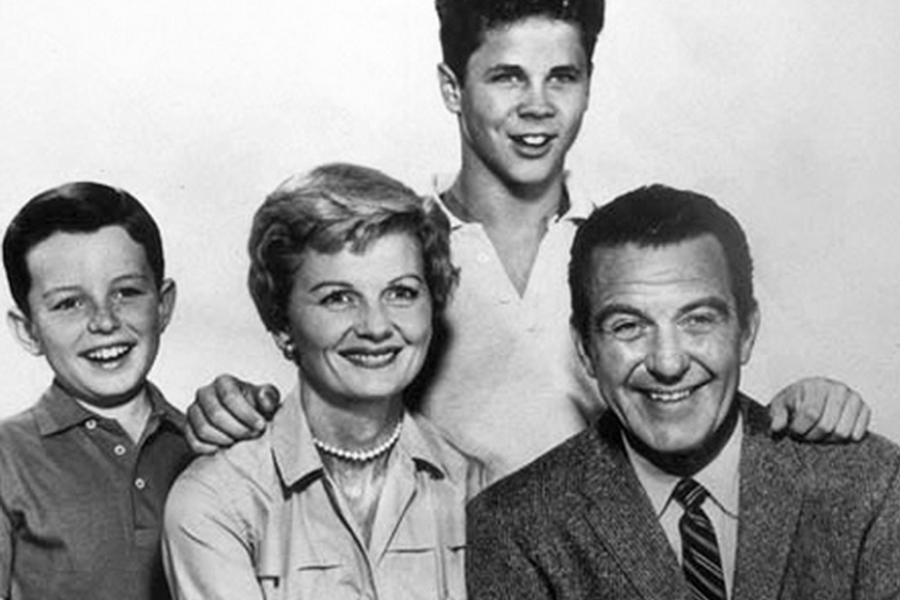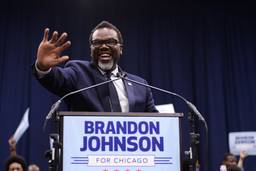The Culture Wars Are Over—And They Aren’t Coming Back
The movements of the 1960s challenged the Leave It to Beaver values of American life, producing the culture wars. But those wars are now finished.
Micah Uetricht

Andrew Hartman’s new book A War for the Soul of America (University of Chicago Press) is an insightful — and, perhaps unavoidably in a book that details political battles like the fight over a photo of a crucifix dunked in urine, often entertaining — history of a period he argues is unique to the United States: the culture wars of the 1980s and ‘90s.
Hartman’s most provocative argument, which has been the focus of many of the book’s reviewers, is that now is a good time for reflection on the culture wars — because they’re over. While plenty of figures on the Right continue to fight battles similar to the ones Hartman chronicles in the book — over allegedly profane speech or LGBTQ issues or gender norms — the overall logic of the period, he argues, has been exhausted.
Expanding far beyond the era’s “greatest hits” like the battle over the misogynist lyrics of the hip-hop group 2 Live Crew or “Piss Christ,” which provoked a fight led by conservative Christian groups over public funding of allegedly blasphemous art, Hartman situates the culture wars in the assaults by 1960s liberation movements on the “normative values” deeply held by many Americans.
Hartman recently came to the In These Times offices to discuss the book. The conversation has been edited for length and clarity.
Can you give us a basic definition of the culture wars? And what was their relationship to the preceding period, the 1960s?
Andrew Hartman: The culture wars rose out of the 1960s. They are specific to the 1980s and 1990s, when national debates about what it means to be an American took on added emphasis, meaning and anger as a result of the social movements of the 1960s. We’re talking about Civil Rights, the Black Power Movement, the other identity movements like the Chicano movement, the feminist movement, gay rights, the antiwar movement — all of these together in the 1960s challenged what I call “normative America.” For shorthand, just think of the values exemplified in a show like Leave it to Beaver.
This may be simplistic, but I think it’s a good way to think about the type of culture that many people during the 1960s rejected and formed movements against. Those movements were very successful, perhaps not always at the political level, but definitely at the cultural level — so much so that various right-wing movements came together to resist the changes to that culture. This is where you have the polarization that defines a lot of the politics and culture of the 1980s and ‘90s. And that’s what I call the culture wars.
At the center of the book is this idea of normative America: the centrality of the white, heterosexual, patriarchal family. And many of those who fought these culture wars see those values as the only thing holding the country together. There was this real existential panic about the country’s ability to survive in the face of these liberation movements.
Yes. And you see this in the rhetoric not just of conservatives and the Christian Right, but also in neoconservatives. They had a very narrow conception of democracy and probably would have been more comfortable talking about defending small-r republican values; that you could only have a society with democratic practices if the people are somehow held in check. And they believed that conservative cultural norms and religious values held people in check and kept them from acting out what they would have called their more “animalistic” instincts. And certainly the way they conceived of these norms were very limited by race, gender and religion.
You mentioned the religious right and neoconservatives. When people talk about neo-cons now, they think about the Iraq war and the Bush era, but neoconservatism meant something else in this period.
When we think about neoconservatives, we think about the most recent iteration of the neo-cons, which supposedly had all this influence in the Bush administration and whose ideological impulse was to reshape the world, especially the Middle East, in our image. But the neoconservatives in their origins were people like Irving Kristol, Norman Podhoretz, Gertrude Himmelfarb, Daniel Patrick Moynihan and Nathan Glazer, who were at various times in their life on the Left. But by the 1960s, most of them were Cold War liberals. And they moved to the Right in reaction to the New Left — in reaction to cultural and domestic policy issues like welfare, crime, affirmative action.
During the ‘60s and ‘70s, they did not write much about foreign policy, and when they did, it was pretty standard Cold War stuff — they were intensely concerned with Soviet power, only tangentially worried about Israel. And even when they did voice concerns about Israel, like during the wars of 1967 and 1973, it was often through a domestic lens. For example, neoconservatives fretted that black American activists like Stokely Carmichael sided with Palestinians out of anticolonial solidarity — an alignment that they saw as consistent with a growing black-Jewish rift over domestic issues like affirmative action. This is not necessarily the way we now think about neoconservatives.
So my argument is that the neoconservatives, more than even the Christian Right, gave Conservatives the language of the culture wars — especially over the major issues of race and gender.
Take a figure like Irving Kristol — a secular Jew, never very religious. But he came to the conclusion that Americans needed Christian values in the middle of the 1970s when the America he understood seemed to be crumbling around him. He came to this conclusion on this bedrock of republican notions that democracy only worked if people were subjected to checks. For him, the best kind of checks were those of culture, like the constraints of Christianity.
Talk about the issues of race and gender and how the movements of the ‘60s and ‘70s fit into the upending of normative America.
These movements of the 1960s confronted the nation with new peoples, new ideals, new articulations of the idea of the nation itself. There was a lot of upheaval in how Americans conceptualized what it meant to be an American.
You see this especially with changing conceptions of race that came out of the Civil Rights and Black Power movements. If you were a liberal on race issues in the middle of the 1960s, you would have seen the passage of the Civil Rights Act of 1964, which granted equal rights regardless of race; the Voting Rights Act of 1965, which abolished restrictions on the ability of African Americans to vote, especially in the Jim Crow South — and you might have thought that we finally have achieved equality, enough said.
But as we get to the 1980s and still see massive levels of racial inequality, which in many ways were actually getting worse — this caused turmoil for intellectuals all over the political map. People had to think about what race meant in terms of American identity in new and different ways.
People like Charles Murray, who was a neoconservative on social policy and informed the Reagan administration’s ideas on race and affirmative action and welfare, argued that there were deficiencies in black culture, that welfare was enabling people to be lazy — very standard for conservatives today, but this emerged out of these cultural debates.
But then you have people on the other side, like Derrick Bell from Harvard Law School, who was arguing that racism was endemic to American life, and perhaps there was no overcoming it. There was this very pessimistic left-wing version of race and American identity, as well.
The issue of modern, Enlightenment values were central to these fights. People were increasingly conceiving of these normative values as a straight jacket. While people on the right were fighting against many of these Enlightenment ideals, many people on the Left were themselves starting to reject Enlightenment values themselves.
Normative America, in this pervasively conservative culture of the 1950s, was a culture of Cold War liberalism. Everyone who was either aligning themselves to the Cold War Left or the Right was rejecting in some fashion Enlightenment values. Cold War Liberals were interested in empirical solutions to problems, and people on both left and right were much more interested in exposing all of that as a mask for white, patriarchal power; and you have people on the right saying it’s a cover for the bureaucracy of the federal government that they were rejecting. So this polarization in many ways moves the right and the left away from centralist liberalism, or takes on a rejection of enlightenment values, to a degree.
A Cold War liberal like Arthur Schlesinger, Jr., the longtime Harvard historian and member of the Kennedy administration, was the classic liberal who comes to be seen during the culture wars as a very conservative figure, because he writes this book in the 1980s called The Disuniting of America, in which he’s arguing against multiculturalism as a rejection of Liberal Enlightenment values.
He’s worried about what he describes as a kind of cultural Balkanization of the U.S.
That’s right. Just as Irving Kristol would have said the nation needs these Christian values as a bedrock that binds us together, Schlesinger would have argued that we need common principles located in, say, the Declaration of Independence and the Constitution: common American values to bind us together. And he was very concerned that many people to his Left were rejecting those values, arguing that they served as a cover for racism or sexism.
You write about people on the Left realizing that, in addition to restrictive ideas about gender and race, perhaps the whole American project is rotten to the core, and they need a different way to define themselves. And so there increasingly was no unifying project for the Left to feel a part of anymore — while the average American still probably wanted to be a part of that kind of project.
There were some people from the ‘60s onward who saw the whole American project as irredeemable: racist, sexist, imperialist. But for the most part that was a very small minority.
Multiculturalists, the people who Schlesinger was arguing against, just wanted the U.S. to reflect what it actually was: a very multicultural society. People wanted to stop the U.S. from thinking of itself as better than others, reject American exceptionalism. But most of these people weren’t giving up the project of the U.S., they just wanted the project to look different. Derrick Bell, the critical race theorist and law professor who I write about in the book, was arguing that America was irredeemable; can never be anything other than racist. But the majority of say, social movement activists and professors in English departments were not going so far as to say that we need to burn the American project to the ground.
But most critics of multiculturalists and others lumped them together with many others much farther to the Left. To conservatives in general, there was no difference to them between multiculturalists and Afro-Centrists. In their eyes, both were rejecting American ideals.
You say that the most radical upending of these normative values was in terms of gender and sexuality.
Perhaps the most pervasive aspect of normative America in the 1950s had a lot to do with gender. Women and men were expected to behave in certain ways. The feminist and gay rights movements just completely obliterated that in a very quick fashion. That, more than anything else, was alarming to many people, especially on the Christian Right, who grounded their view of the world in very strict gender norms.
Let’s get into some of the “greatest hits” of this era. You say that The Last Temptation of Christ was perhaps the key battle of the culture wars.
The Last Temptation of Christ was a Martin Scorsese-directed film that came out in 1988, based on a novel from the 1950s, that tried to reimagine the life of Jesus and make him much more human than many people wanted him to be. In the New Testament, before Jesus is crucified, he has all these temptations and Scorsese thus wanted to depict a Jesus tempted by what most 27-year old men are tempted by: sex. But many religious conservatives in the U.S. have deemphasized these temptations because they envision Jesus through their normative political and cultural visions, which emphasize that sex outside of heterosexual marriage is sinful.
Scorsese spent a decade trying to get this produced, which was so hard because it was so controversial, because he emphasized Jesus’s indiscretions, which did not go over well. To me this is a key moment in the culture wars because it demonstrated the cultural gap between mainstream Hollywood and many Americans who completely rejected the film.
The studio was receiving something like a million pieces of mail per week about this, right?
James Dobson, a Christian Right radio leader, said on his “Focus on the Family” radio program that it was the most anti-Christian movie ever made, before admitting that he hadn’t seen it. They had sent out this early version of the script that was very graphic sexually, and this made its way into millions of Americans’ homes through direct mail sent by Christian Right groups like Moral Majority, and it became ammunition for them to mail letters to the studio to try to convince them not to produce the film. The first studio, in fact, dropped the film, even though they were all set to begin filming, because of the controversy. When it opened, it was only in about 12 select cities, and you can imagine the cities: Chicago, New York, San Francisco. And even then there were these massive protests outside the theaters.
And “Piss Christ”?
Piss Christ is a piece of art from Andres Serrano; I think he made it in 1987. It’s a photographic image of a jar of the artist’s urine and blood in which a crucifix is submerged. The big controversy emerged when it was discovered that the National Endowment for the Arts had funded it. These funds go through Congress. When it was discovered that the NEA had funded an exhibit that had allowed Piss Christ to be shown at exhibits throughout the country and had allowed Piss Christ to travel around, that was pretty disturbing to people like Jesse Helms, perhaps the most conservative member of the Senate, from North Carolina, who waged war on the NEA for about five years
“Piss Christ,” you say, was not critically well-received. This kind of art seems to be what we would consider “trolling” today, right? It’s like, “Hey Christians — look at this picture of Jesus in a jar of urine! Are you mad? Are you?!’
Right. And if there was one guarantee to generate controversy, “Piss Christ” was it.
You argue, pretty provocatively, in your conclusion that the culture wars are largely over.
To me, the logic of the cultural wars seems largely exhausted. The Christian right in many ways is kind of a lost cause. You have an increasing number of conservative religious figures who are arguing the need to withdraw from public culture and create their own autonomous cultural zones, where they can prepare for when the U.S. is once again ready for its ideals.
Many conservative Christians, for example, still believe that homosexuality is not only an abomination in the eyes of God but also a threat to national values. But they are less likely to make that argument publicly and politically; instead their main tactic is “religious freedom.” To me, this is a recognition that they are losing the national battle, and they’re trying to create smaller zones in which they can discriminate in the name of religious freedom.
It does feel like we’re seeing the last gasps of some of these forces. On the other hand, there are plenty of examples in American history of when forces on the Right are seemingly defeated, and then just a few years later, they are ascendant.
I’m not arguing that the Right is vanquished — far from it. But I think that the economic right is just much more where the focus is right now. Cultural conservatives and the Christian Right are not at the forefront of conservatism.
You write in your introduction about Thomas Frank’s What’s the Matter with Kansas? Part of the thesis in that book is that the Right has carried out this great swindle and has convinced largely rural, fundamentalist Christians to be the foot soldiers of a right-wing economic agenda that ultimately screws them. The “silent majority’s” cultural anger gets used to achieve economic ends for the elites. How is Frank’s argument wrong?
I think it’s a little too dismissive of how important these culture war issues were to millions of people. Politicians by their very nature will be opportunistic. Many conservative politicians were opportunistic when it came to issues like abortion. But that doesn’t mean that the people who were voting Republican because of that issue were just duped. If you were living in Kansas, and you were conservative culturally, are you going to vote for the party that is going to speak to your deeply felt cultural values, or for the party which maybe can get you an extra $200 in your paycheck? You are going to vote for the party that represents you culturally and religiously.
What’s the lesson to take from that for the Democratic Party? Or the Left as a whole?
If you think about the Left’s victories in the 1960s, you see that the nation is far less sadistic than it was, in terms of race and gender from the previous decade. We can point to many, many successes. These are successes wrapped up in cultural values and cultural rights. People now can say they are part of the common culture in ways they previously couldn’t.
I spent a year living in Denmark while finishing writing this book. Denmark is a country of 5 million people, mostly white Danes. They have a lot of immigrants, and that’s increasingly an issue. Compared to the United States, it’s a homogenous culture. Perhaps one of the best five social democracies in the world. Do these things work together? Can we have this cultural revolution that was so successful in the 1960s, and also have a social democracy in the United States? I want to be optimistic and say yes, but that’s also the problem we have to think about.
Have other countries experienced their own culture wars? Is there any element that is international?
I don’t think there is an analog in other countries. This is a peculiarly American thing. It’s not that other countries don’t have heated debates about cultural issues. But I don’t think you can talk about France from the 1960s through the 21st century as being riveted by these cultural wars.
The United States has always been about an idea, much more so than other nations, and this idea is debatable. It is unstable, and lends itself to cultural conflict.
This is the kind of question that historians hate to be asked, but: Could it have been done differently? Politicians like Ronald Reagan rode these culture wars into power and carried out an incredibly damaging economic and social agenda. Was there anything that the Left could or should have done in the 1960s or ‘70s that would not have engendered this massive backlash?
The common white liberal argument is, if we would have just toned down our rhetoric, we could have gotten these achievements without the conservative backlash. That’s fantasy. Any time the Left wins any victories whatsoever, there’s going to be a backlash from the Right. People aren’t going to give up their privileges without a fight.
Micah Uetricht is an editor at Jacobin magazine. He is a contributing editor and former associate editor at In These Times, and the author of Strike for America: Chicago Teachers Against Austerity and coauthor of Bigger Than Bernie: How We Go From the Sanders Campaign to Democratic Socialism, and is currently at work on a book on New Leftists who took jobs in industries like steel and auto to organize on the shop floor.








